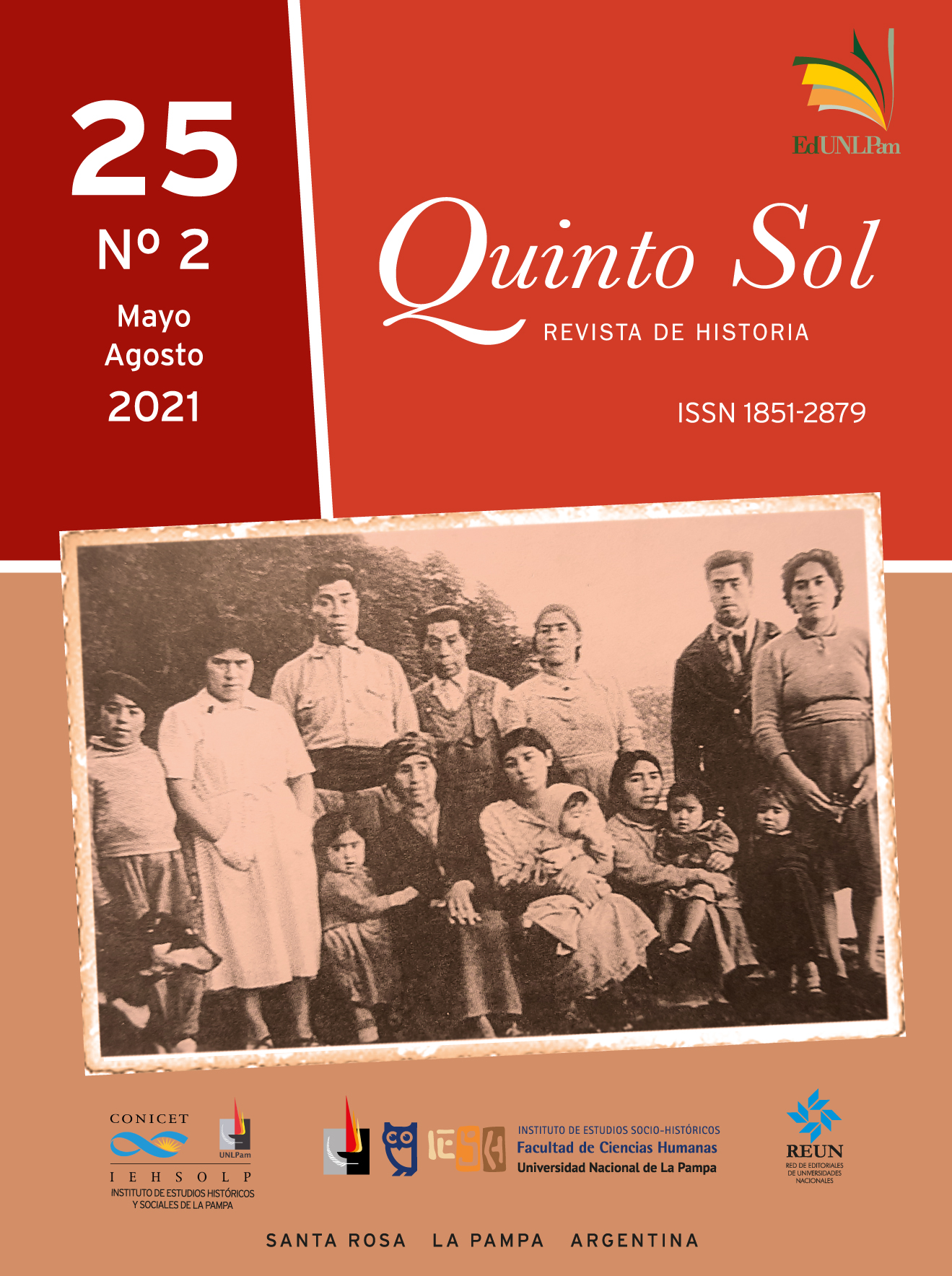Neighbors denounce the Turkish bolichero. Territorial conflicts between Arab merchants and local settlers in the northwest of Chubut (1910-1955)
DOI:
https://doi.org/10.19137/qs.v25i2.4977Keywords:
migratory studies, syrian-lebanese, agrarian history, landAbstract
This article studies different territorial conflicts between Arab merchants and neighboring indigenous peoples, creoles, and immigrants in the northwest of the National Territory of Chubut during the first half of the 20th century. Different cases are followed-up through documents produced by the Dirección Nacional de Tierras (National Land Directorate) and the Chubut governorate, advancing in generalizations that allow discussing the speeches that have simplified the processes of land appropriation. Based on these cases, we propose to review the usual historiographic periodization about the beginning of the processes of enclosure and the territorial conflicts that staged the Syrian-Lebanese immigrants. It is argued that the Arab merchants, by introducing perimeter fences, broke a previous territorial ordering based on occupations that were not delimited and that were generally regulated by neighborhood agreements. The historiographical reconstruction shows that the Syrian-Lebanese bolicheros managed to maintain and expand their enclosures after long-term administrative processes, gradually imposing a new order marked by private appropriation of land.Downloads
References
Argeri, M. E. (2005). De guerreros a delincuentes. La desarticulación de las jefaturas indígenas y el poder judicial. Norpatagonia, 1880-1930. Consejo Superior de Investigaciones Científicas.
Bascopé Julio, J. (2008). Pasajeros del poder propietario. La Sociedad Explotadora de Tierra del Fuego y la biopolítica estanciera (1890-1920). Magallania, 36 (2), 19-44. http://www.magallania.cl/index.php/magallania/article/view/305
Chávez, M. (2018). De bolichero turco a ganadero árabe. La construcción territorial de un inmigrante libanés en el noroeste del Chubut (1907-1927). Páginas. Revista Digital, 10 (23), 84-100. https://doi.org/10.35305/rp.v10i23.302
Delrio, W. (2005). Memorias de expropiación. Sometimiento e incorporación indígena en la Patagonia: 1872-1943. Universidad Nacional de Quilmes.
Escolar, D., Salomón Tarquini, C. y Vezub, J. (2015). La “Campaña del Desierto” (1870-1890): notas para una crítica historiográfica. En F. Lorenz (Comp.) Guerras de la historia argentina (pp. 223-247). Ariel.
Figueroa, L. (2018). Procesos de transformación social a partir de la distribución de tierras fiscales en Chubut. El caso de Cholila (finales del siglo XIX-comienzos del siglo XXI. En G. Blanco (Ed.) La tierra pública en la Patagonia. Normas, usos, actores sociales y tramas relacionales (pp. 203-226). Prohistoria.
Finkelstein, D., Novella M. M. y Gavirati, M. (2005). Sociedad y economía del noroeste de Chubut (1880-1920). En D. Finkelstein y M. M. Novella (Comps.) Poblamiento del Noroeste del Chubut. Aportes para su historia (pp. 11-31). Fundación Ameghino.
Fradkin, R. (2009). ¿Misión imposible? La fugaz experiencia de los jueces letrados de Primera Instancia en la campaña de Buenos Aires (1822-1824). En D. Barriera (Comp.) Justicias y Fronteras. Estudios sobre historia de la justicia en el Río de la Plata (Siglos XVI-XIX) (pp. 143-164). Universidad de Murcia, Servicio de Publicaciones. Red Columnaria.
Macchi, G. (2013, 10 de octubre). Los sirio-libaneses y su participación en el temprano desarrollo económico del noroeste del Chubut 1900-1940 [ponencia]. X Congreso de Historia Social y Política de la Patagonia Argentino-Chilena. Trevelin, Argentina.
Marín, R. (1933). Hablan desde la cárcel los hijos del Martín Fierro. Librerías Anaconda.
Netz, R. (2013). Alambre de púas: una ecología de la modernidad. Editorial Universitaria de Buenos Aires.
Pérez, P. (2016). Archivos del silencio. Estado, indígenas y violencia en Patagonia central, 1878-1941. Prometeo.
Pérez, P. (2018). Haciendo las policías en Patagonia Central (1884-1950s): proyectos, prácticas y experiencias de la producción del espacio social. En M. Moroni, F. Casullo y G. Carrizo (Eds.) Justicia, seguridad y castigo. Concepciones y prácticas cotidianas en Patagonia (1884-1955) (pp. 119-145). Prohistoria/ EdUNLPam.
Rafart, G. (2008). Tiempo de violencia en la Patagonia. Bandidos, policías y jueces 1890-1940. Prometeo.
Richard, N. y Hernández, C. (2018). Las alambradas en la Puna de Atacama: alambre, desierto y capitalismo. Revista Chilena de Antropología, 37, 83-107. DOI: 10.5354/0719-1472.2018. 49480
Ripa, J. (1987). Inmigrantes en la Patagonia. Marymar.
Salomón Tarquini, C. (2011). Procesos de subalternización de la población indígena en Argentina: los ranqueles en La Pampa, 1870-1970. Revista de Indias, 71 (252), 545-570. https://doi.org/10.3989/revindias.2011.018
Sourrouille, M. (2017). Nahuelpan, Colonia 16 de octubre y Argentine Southern Land Co.: la colonización del territorio nacional del Chubut (1885-1937) [tesis de doctorado, Universidad de Buenos Aires]. http://repositorio.filo.uba.ar/handle/filodigital/6117
Tozzini, A. (2018). Indígenas, extranjeros y funcionarios. Producción burocrática y estrategias de acceso a la tierra en Colonia y Reserva Gualjaina, Territorio Nacional del Chubut. En G. Blanco (Ed.) La tierra pública en la Patagonia. Normas, usos, actores sociales y tramas relacionales (pp. 277-296). Prohistoria.
Troncoso, A. M. (2015). Todavía no: el proyecto civilizador entre las prácticas sociales y las estrategias de resistencia, de negociación y de apropiación en la meseta norte chubutense (1900-1970). Edición de la autora.
Downloads
Additional Files
Published
Issue
Section
License
When submitting their contributions, authors must declare that they have the permission of the file or repository where the documents that are attached to the work were obtained, whatever their format (unpublished manuscripts, images, audiovisual files, etc.). Such permission authorizes their publication and reproduction, releasing the journal and its editors from any liability or claim from third parties.
Likewise, authors must adhere to the Creative Commons license called "Attribution - Non-Commercial CC BY-NC-SA", through which the author allows copying, reproducing, distributing, publicly communicating the work and generating derivative works, as long as the original author is properly quoted and acknowledged. It is not allowed, however, to use the work for commercial purposes. Authors may establish additional agreements for the non-exclusive distribution of the version of the paper published in the journal (for example, placing it in an institutional repository or publishing it in a book), with the acknowledgment of having been published first in this journal.
The publication of content in this journal does not imply any royalty or charge for taxpayers.
Quinto Sol adheres to the DORA (Declaration on Research Assessment) signed in San Francisco, California, on December 16, 2012, and to the Declaration of Mexico (Joint Declaration LATINDEX - REDALYC - CLACSO - IBICT).










4.png)
2.png)












_(2).png)


1.jpg)



1.jpg)





